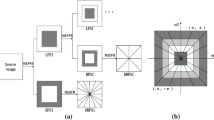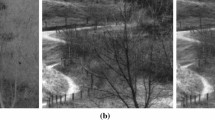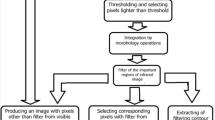Abstract
The goal of infrared (IR) and visible image fusion is for the fused image to contain IR object features from the IR image and retain the visual details provided by the visible image. The disadvantage of traditional fusion method based on independent component analysis (ICA) is that the primary feature information that describes the IR objects and the secondary feature information in the IR image are fused into the fused image. Secondary feature information can depress the visual effect of the fused image. A novel ICA-based IR and visible image fusion scheme is proposed in this paper. ICA is employed to extract features from the infrared image, and then the primary and secondary features are distinguished by the kurtosis information of the ICA base coefficients. The secondary features of the IR image are discarded during fusion. The fused image is obtained by fusing primary features into the visible image. Experimental results show that the proposed method can provide better perception effect.
Similar content being viewed by others
References
Goshtasby A A, Nikolov S. Image fusion: Advances in the state of the art. Information Fusion, 2008, 8(2): 114–118
Mahmood A, Tudor PM, Oxford W, Hansford R, Nelson J D B, Kingsbury N G, Katartzis A, Petrou M, Mitianoudis N, Stathaki T, Achim A, Bull D, Canagarajah N, Nikolov S, Loza A, and Cvejic N. Applied multi-dimensional fusion. The Computer Journal, 2007, 50(6): 660–673
Sinha A, Chen H M, Danu D G, Kirubarajan T, Farooq M. Estimation and decision fusion: a survey. Neurocomputing, 2008, 71(13–15): 2650–2656
Piella G. A general framework for multiresolution image fusion: from pixels to regions. Information Fusion, 2003, 4: 259–280
Liu K, Guo L, Li H H, Chen J S. Fusion of infrared and visible light images based on region segmentation. Journal of Aeronautics, 2009, 22(1): 75–80
Zhang X Q, Gao Z S, Zhao Y H. Dynamic infrared and visible image sequence fusion based on DT-CWT using GGD. In: Proceedings of the 2008 International Conference on Computer Secience and Information Technoogy. 2008, 875–878
Bartlett MS, Martin H, Sejnowski T J. Face image analysis by unsupervised learning and redundancy reduction. PhD Dissertation. La Jolla: University of California San Diego and the Salk Institute, 1998
Hyväriene A, Karhunen J, Oja E. Independent Component Analysis. London: John Wiley and Sons, 2001
Kwon O W, Lee T W. Phoneme recognition using ICA-based feature extraction and transformation. Signal Processing, 2004, 84: 1005–1019
Dorffner G, Bischof H, Hornik K. Feature extraction using ICA. Lecture Notes in Computer Science, 2001, 2130: 568–573
Zhang L P, Huang X. Object-oriented subspace analysis for airborne hyperspectral remote sensing imagery. Neurocomputing, 2010, 77(4–6): 727–936
Hyvärinen A, Oja E. Independent component analysis: algorithms and applications. Neural Networks, 2000, 13: 411–430
Hyvärinen A, Oja E, Hoyer P, Hurri J. Image feature extraction by sparse coding and independent component analysis. In: Proceedings of the 14th International Conference on Pattern Recognition. 1998, 2: 1268–1273
Kwak N, Choi C H, Ahuja N. Face recogniton using feature extraction based on Independent Component Analysis. Image Processing, 2002, 2: 337–340
Mitianoudis N, Stathaki T. Pixel-based and Region-based image fusion schemes using ICA bases. Information Fusion, 2007, 8(2): 131–142
Mitianoudis N, Stathaki T. Image fusion schemes using ICA bases. London: Communications and Signal Processing Group, 2008
Mitianoudis N, Stathaki T. Optimal contrast correction for ICA-based fusion of multimodal images. IEEE Sensors Journal, 2008, 8(12): 2016–2016
Mitianoudis N, Stathaki T. Adaptive image fusion using ICA bases. In: Proceedings of the 2006 International Conference on Acoustics, Speech and Signal Processing. 2006, 829–832
Cvejic N, Bull D, Canagarajah N. Region-based multimodal image fusion using ICA bases. IEEE Sensors Journal, 2007, 7(5): 743–751
Chen F R, Qin F, Peng G X, Chen S Q. Fusion of remote sensing images using improved ICA mergers based on wavelet decomposition. Procedia Engineering, 2012, 29: 2938–2943
Bell A J, Sejnowski T J. The Independent components of natural scenes are edge filters. Vision Research, 1997, 37: 3327–3338
Yang H H, Moody J. Data visualization and feature selection: new algorithms for nongaussian data. In: Proceedings of Advances in Neural Information Processing Systems. 1999, 687–693
Lewicki S M, Sejnowski T J. Learning overcomplete representations. Neural Computation, 2000, 12(2): 337–365
Hyvärinen A, Oja E. A two-layer sparse coding model learns simple and complex cell receptive fields and topography from natural images. Vision Research, 2001, 41(18): 2413–2423
Glasner D, Bagon S, Irani M. Super-Resolution from a Single Image. In: Proceedings of the 2009 International Conference on Computer Vision. 2009, 349–356
Hyvärinen A. Fast and robust fixed-point algorithms for independent component analysis. IEEE Transactions on Neural Networks, 1999, 10(3): 626–634
Zhang Z, Blum R S. A categorization of multiscale-decompositionbased image fusion schemes with a performance study for a digital camera application. Proceedings of the IEEE, 1999, 87(8): 1315–1326
Pajares G, Cruz J. A wavelet-based image fusion tutorial. Pattern Recognition, 2004, 37(9): 1855–1872
The image fusion server. http://www.imagefusion.org/.
Xydeas C S, Petrovic V. Objective pixel-level image fusion performance measure. Electronics Letters, 2000, 36(4): 308–309
Piella G, Heijmans H. A new quality metric for image fusion. In: Proceedings of the 2003 International Conference on Image Processing. 2003, 3: 173–176
Petrovic V. Subjective tests for image fusion evaluation and objective metric validation. Information Fusion, 2007, 8(2): 208–216
Elad M, Aharon M. Image denoising via sparse and redundant representations over learned dictionaries. IEEE Transactions on Image Processing, 2006, 15(12): 3736–3745
Yang B, Li S T. Pixel-level image fusion with simultaneous orthogonal matching pursuit. Information Fusion, 2012, 13(1): 10–19
Naidu VPS. Image fusion technique using multi-resolution singular value decomposition. Defence Science Journal, 2011, 61(5): 479–484
Li S T, Yang B, Hu J W. Performance comparison of different multiresolution transforms for image fusion. Information Fusion, 2011, 12: 74–84
Author information
Authors and Affiliations
Corresponding author
Additional information
Yin Lu received her BS in electronic and optical engineering from Nanjing University of Science and Technology, China in 2010. Now she is studying the MS degree in School of Electronics and Information Engineering of Beihang University, China. Her current research interests lie in the areas of image fusion and aviation surveillance.
Fuxiang Wang received the BS in 1999 and the PhD in 2007, all from Beihang University, China. He is currently a lectuer with the School of Electronics and Information Engineering, Beihang University, China. His current research interests lie in the areas of blind source separation and their applications.
Xiaoyan Luo received the BS in communication engineering from Taiyuan University of Technology, China in 2004 and received the MS in communication and information system in 2007 and PhD degree in electronics and information engineering in 2011 both from Beihang University, China. She is currently a lectuer with the Image Processing Center, School of Astronautics, Beihang University, China. Her research interests include image fusion and pattern recognition.
Feng Liu is a professor with the School of Electronic and Information Engineering, Beihang University, China. He obtained a PhD in control science and engineering from Xi’an Jiaotong University, China in 2000. His main research interests include communication, computer network, and complex network.
Rights and permissions
About this article
Cite this article
Lu, Y., Wang, F., Luo, X. et al. Novel infrared and visible image fusion method based on independent component analysis. Front. Comput. Sci. 8, 243–254 (2014). https://doi.org/10.1007/s11704-014-2328-2
Received:
Accepted:
Published:
Issue Date:
DOI: https://doi.org/10.1007/s11704-014-2328-2




